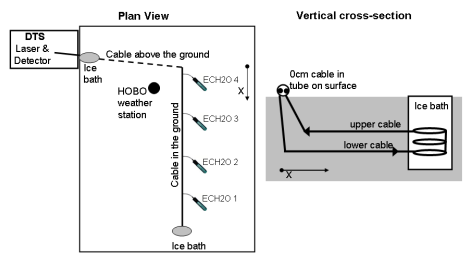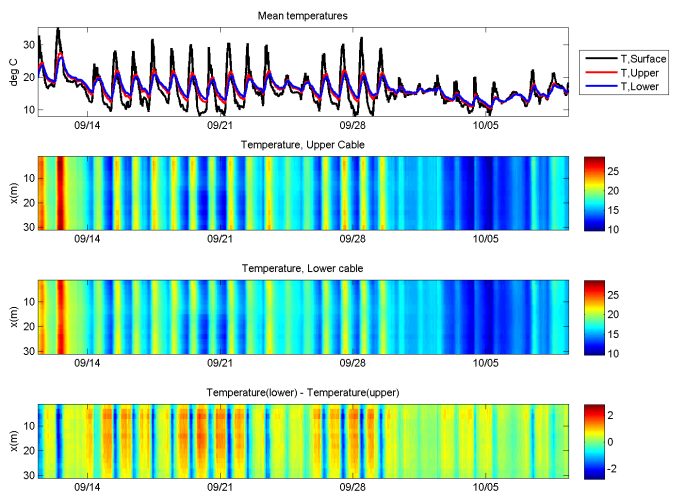Soil moisture estimation using Distributed Temperature Sensing
Soil moisture is a key state variable in surface hydrology and land-atmosphere interactions. It is a storage term in the water balance, determining how much incident precipitation can infiltrate into the soil and how much will be lost as run-off. In the energy balance, it partitions the net radiation between latent, sensible and ground heat fluxes. Thus, it determines how much water and energy is available for exchanges with the atmosphere.
In November 2009, ESA launched the first dedicated soil moisture remote-sensing mission (SMOS). In 2013, NASA will launch its Soil Moisture Active and Passive (SMAP) satellite. Data from these missions will be used to improve our understanding of the global energy and water budgets. However, the value of the observations can only be determined through a global network of independent in-situ soil moisture measurements over varying soil and land cover types. Point observations of soil moisture are easy to make using established methods such as time-domain reflectometry (TDR) and gravimetric sampling. TDR is a useful method to make continuous, long-term measurements as it is non-destructive, and sensors can be installed at the site of interest. However, monitoring large scale variability with TDR would involve installing a vast network of sensors, which is logistically and economically infeasible. A way must be found to bridge the gap from traditional point-scale observations to footprint (3-40km) scale.
SoilDTS is an experimental method of measuring soil moisture based on Distributed Temperature Sensing (DTS), which can yield information on soil moisture variability at high resolution (1-2m) over a large area. In DTS, inexpensive telecommunications fiber-optic cable is used to produce accurate (<0.1K) measurements of temperature at high resolution (1-2m) over long cables. To measure soil moisture, two to four fiber-optic cables, up to several kilometers in length, are plowed into the soil and DTS equipment is used to measure their temperatures every 1-2m. Temperature changes can be due to the diurnal radiation cycle (‘passive DTS’) or due to a heat pulse transmitted from the metal housing of one of the cables (‘active DTS’). Heat transport between cables depends on the thermal properties of the soil, which are functions of soil moisture. Observing temperature dynamics with DTS can therefore provide a way to determine the soil moisture. To measure soil moisture two to four fibre-optic cables, up to 5km in length, are plowed into the soil and DTS equipment is used to measure their temperatures every 1-2m. Temperature changes can be due to the diurnal radiation cycle (‘passive DTS’) or due to a heat pulse transmitted from the metal housing of one of the cables (‘active DTS’). Heat transport between cables depends on the thermal properties of the soil, namely thermal conductivity and thermal capacity, both of which are functions of soil moisture. Observing the temperature in the cables therefore provides a way to determine the soil moisture.
From June to September 2008, we used fibre-optic cables to monitor temperature at 5cm and 10cm depth at a field site at Monster in the Netherlands. Meteorological data, as well as independent soil temperature and soil moisture profile data were also recorded.

Figure 1: Site layout and cable installation at Monster, Summer 2008. (Steele-Dunne et al., 2010)

Figure 2: Temperature data measured using distributed temperature sensing at Monster, Summer 2009. "x" is distance from the DTS unit in metres.(Steele-Dunne et al., 2010) |
Through its impact on diffusivity, soil moisture influences heat transport between the cables. By solving for the optimum parameters of the advection-diffusion equation, we could yield a time-series of 3-hourly soil moisture (Steele-Dunne et al., 2010). We have also used data assimilation to estimate soil moisture using the same data. A dual state-parameter estimation approach was used to combine observed temperaure data from SoilDTS with a coupled heat and moisture transfer model. Temperature was estimated as a state using the Ensemble Kalman Filter, while soil moisture was estimated as a parameter of the system. This approach yields an estimate of the soil temperature and moisture profiles as well as an estimate of soil heat flux in the profile. By estimating soil moisture at fine resolution over large areas, this SoilDTS offers a unique opportunity to quantify the temporal and spatial variability in soil moisture at different scales. It provides a way to relate point in-site soil moisture measurements to footprint-scale estimates from remote sensing.
This is an ongoing project that includes elements of fieldwork, physics, modeling, data assimilation and geostatistics. If you are interested in contributing, please contact Susan Steele-Dunne.